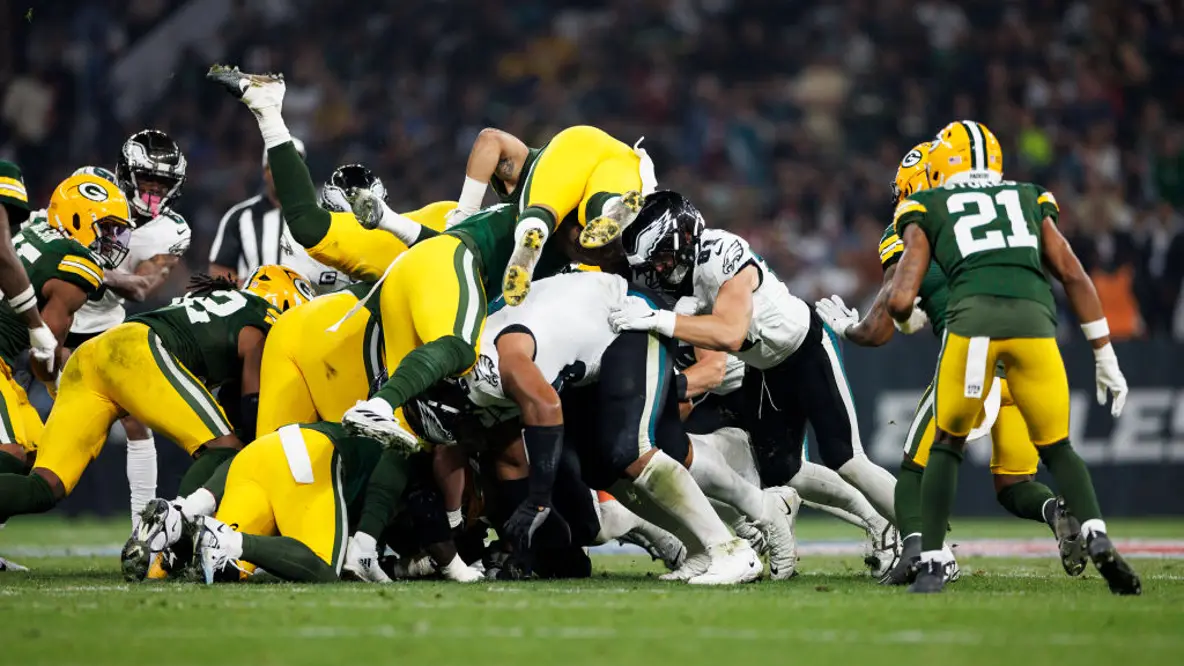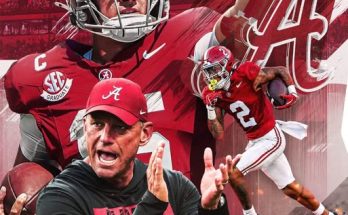The Philadelphia Eagles have long been one of the NFL’s most successful franchises, but recently they’ve found themselves at the center of controversy due to one of their most effective and unconventional plays—the “tush push”. This play, a powerful short-yardage maneuver, involves the quarterback being pushed by his teammates from behind, typically during critical fourth-and-short or goal-line situations. It has been highly effective for the Eagles, especially with their star quarterback Jalen Hurts, and has led to considerable debate among players, coaches, analysts, and fans alike. The debate revolves around whether the play is fair or if it puts too much strain on player safety.
As the play became increasingly controversial throughout the 2023 season, with other teams expressing frustration and calling for a ban, the NFL has stepped in to evaluate its legality. But in a stunning move, the league recently announced that it has postponed making a final decision about whether the “tush push” should remain a part of the NFL playbook. This has left many to wonder: Why the delay, and what does this mean for the future of the NFL’s rulebook?
In this article, we’ll explore the controversial nature of the “tush push”, why the NFL has decided to hold off on making a final ruling, and the potential ramifications for the league going forward.
The Tush Push: What Is It?
To understand why the “tush push” has caused so much controversy, we first need to break down what the play entails. The play itself is a variation of a quarterback sneak. However, unlike the traditional sneak, which involves the quarterback plunging forward a yard or two by himself, the tush push relies on teammates helping the quarterback by pushing him from behind.
In the Eagles’ version of the play, Jalen Hurts—a powerful, athletic quarterback known for his strength and ability to move the pile—lines up in a traditional quarterback sneak formation, but he is immediately assisted by his offensive line and even sometimes a tight end or a running back. These teammates push Hurts forward, usually with momentum that makes it nearly impossible for defenders to stop the play from converting short-yardage situations.
The tush push has proven incredibly effective, especially for the Eagles, who have converted on nearly 100% of their attempts in 2023. It’s particularly effective in situations where Hurts’ ability to gain a few inches or a yard is a significant advantage. In fact, Hurts, who is built like a power-running back, is almost always able to gain the necessary yardage with the help of his teammates’ powerful push.
The play’s effectiveness has raised eyebrows around the league, leading to much debate about whether it’s an unfair tactic or simply a clever innovation. As the play became more successful, it was quickly dubbed the “tush push”, with the name catching on among fans and commentators alike.
The Controversy: Should the Tush Push Be Banned?
While the tush push has been a potent weapon for the Eagles’ offense, it has also garnered significant criticism from opposing teams and players. The main issue centers on the legality and safety of the play.
Player Safety Concerns
One of the main concerns about the tush push is player safety. The NFL has made significant strides in recent years to protect its players, particularly quarterbacks, from injury. The league has instituted rules that limit dangerous hits on quarterbacks, implemented concussion protocols, and taken steps to address high-impact collisions. However, the tush push is different because it involves a concentrated force being applied to the quarterback’s body from behind, which puts additional pressure on his spine and neck. In a situation where defensive players are also trying to stop the push, the potential for injury increases dramatically.
Critics argue that pushing a quarterback forward in this manner could result in dangerous neck or back injuries, especially when defenders are engaged in the scrum trying to stop the play. The NFL has been under immense pressure to ensure player safety, and the tush push has raised concerns that this play might cross a line in terms of risk to the players involved.
Furthermore, the offensive linemen, who are often pushing from behind, are also exposed to potential injuries in these high-impact situations. The NFL’s concerns about health and safety are compounded by the fact that the tush push is often run in goal-line or short-yardage situations, where the chances of a big collision are higher.
The Argument of Fairness
Another key issue with the tush push is its perceived unfairness. Some opponents of the play argue that it gives the Eagles a significant competitive advantage. In many ways, the play feels like a loophole in the rules. While quarterback sneaks are not uncommon in the NFL, the fact that players are allowed to push the quarterback from behind makes the play almost impossible to stop, especially when executed by a quarterback like Hurts, who is incredibly strong and has the physicality to power through defenders.
Other teams around the NFL have voiced frustration, arguing that the tush push is a play that is not only difficult to defend but one that alters the balance of power in short-yardage situations. For instance, teams with less physically imposing quarterbacks or less dominant offensive lines may struggle to execute such a play with the same effectiveness as the Eagles. As a result, they argue that the tush push is an unfair tactic, giving a select few teams an outsized advantage in these critical situations.
Some have gone as far as to call the play “cheating,” contending that it relies on a technicality in the rules, one that is not explicitly addressed. The logic behind this argument is that by allowing teammates to push the quarterback from behind, the NFL may be permitting a play that’s too effective to be considered fair within the existing rulebook.
The Counterarguments: Why the Tush Push Should Be Allowed
Despite the criticisms, there are compelling arguments in favor of allowing the tush push to remain in the game. Proponents argue that the play is simply a part of football’s natural evolution. Just as the wildcat formation and RPOs (run-pass options) became innovative plays that took the league by storm, the tush push is another example of offensive creativity.
From the perspective of the Eagles, the tush push is no different from any other type of short-yardage play that relies on brute force and strategy. Teams like the Eagles should be allowed to use whatever tactics they deem effective, so long as they’re within the existing rules of the game. It’s part of football’s tradition of teams developing new strategies to outsmart and outmuscle opponents.
Furthermore, the argument against the tush push often overlooks the fact that NFL players, by nature, are highly trained athletes who know the risks involved in playing such a physical game. Pushing a quarterback from behind, while unconventional, is not significantly different from any other type of tackle or short-yardage play in terms of impact. The danger posed by the play may not be as significant as critics suggest, especially considering that similar strategies, like fullback dives and short-yardage runs, have been a staple of football for decades.
Finally, the tush push could be viewed as an answer to a broader philosophical question about football: Should the game penalize teams for trying to innovate and be creative? After all, football is about adapting, adjusting, and finding new ways to win. The tush push could be seen as simply another example of a team finding a way to gain an edge in a tough, physical game.
The NFL’s Decision: Why the Delay?
The NFL’s decision to postpone making a final ruling on the tush push has left many wondering why the league has chosen to hold off on making a definitive call.
One reason for the delay could be the league’s commitment to thoroughly researching the play’s impact and reviewing the data. NFL teams have extensive resources, including coaches, medical staff, and analysts, and it’s possible that the league wants to conduct a more comprehensive study of the play’s effects on player safety. The NFL could be gathering additional data on injury rates from similar plays and evaluating whether further action is necessary.
Another potential reason for the delay could be a desire to let the season play out. By postponing a ruling until after the season, the league may be giving teams a chance to adjust to the play and see how its use evolves. There’s a possibility that the tush push could lose effectiveness as teams develop defensive countermeasures or as rule changes are implemented to neutralize it.
The delay also gives the league more time to consult with the Players Association (NFLPA), coaches, and other stakeholders to ensure that any changes made to the rules are in the best interest of the game. The NFL has often faced backlash in the past for making rash decisions on rule changes, so the league may be taking a cautious approach to ensure that it doesn’t make a hasty decision that could backfire.
The Future of the Tush Push
As the NFL continues to deliberate on the future of the tush push, the controversy surrounding the play seems far from over. The decision to postpone making a final ruling has only added to the tension, leaving fans, players, and coaches alike eagerly awaiting the league’s eventual decision. Whether or not the tush push remains a part of the NFL will depend on a complex interplay of safety concerns, fairness, and the league’s desire to maintain competitive balance.
For now, the Philadelphia Eagles will continue to use the play to their advantage, and opponents will look for ways to counter it. The NFL’s ultimate decision will have far-reaching consequences, and it’s clear that this issue will be one of the most discussed topics in the league for the foreseeable future.



